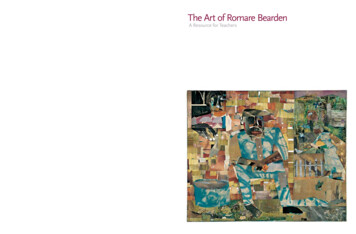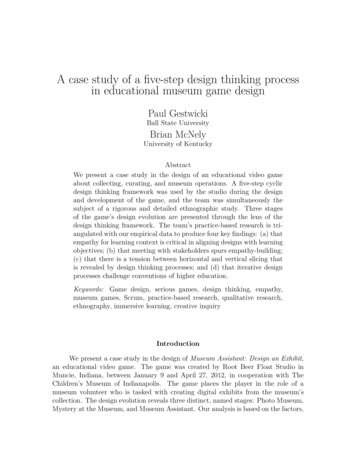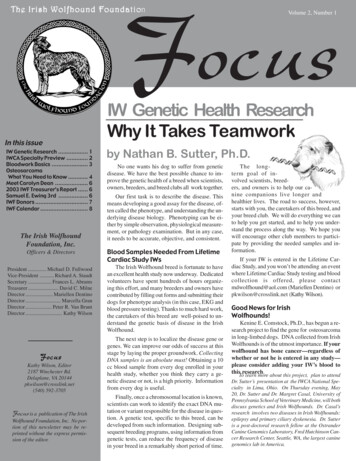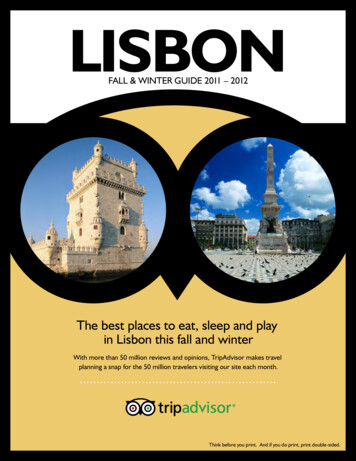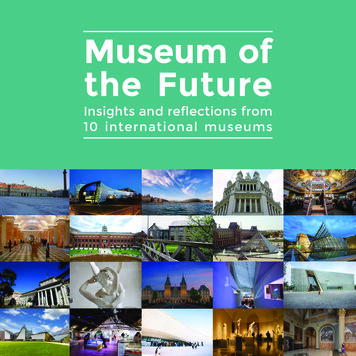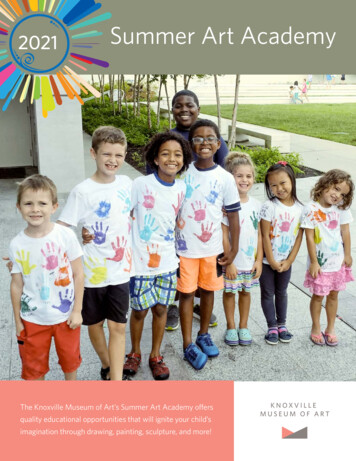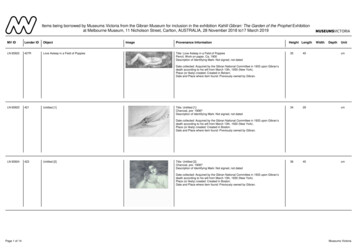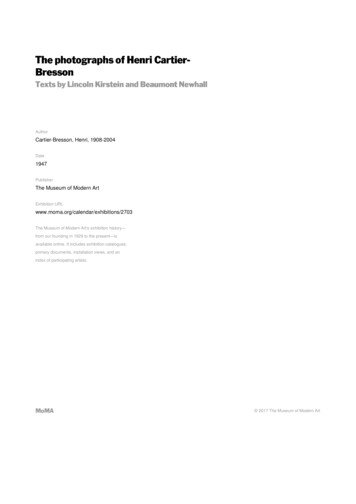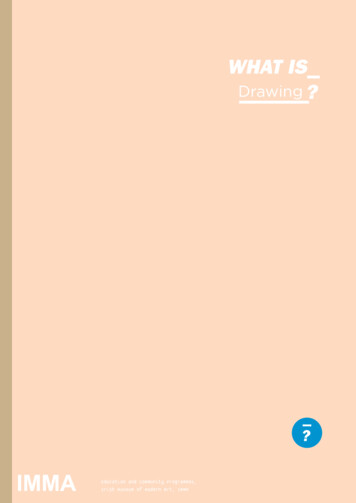
Transcription
WHAT IS––Drawing on and Community Programmes,Irish Museum of Modern Art, IMMA
WHAT IS–––––––?materials and –––––––––––––There is a growing interest in contemporary art, yet the ideas,methodologies and the theoretical frameworks which inform its practicecan be complex and difficult to access. The What is ? information programmeis intended to provide a broad overview of some of the central themesand directions in modern and contemporary art and also to provideinformation about the materials and methodologies employed by artistsin the creation of their work.03Drawing on the expertise and experience of lecturers, artists, curators andcritical writers, this programme offers a range of perspectives and is neitherdefinitive nor exhaustive.The programme addresses aspects of modern and contemporary arttheory and practice and comprises talks, booklets and web-based resources:Series 11970 to the presentSeries 21900 to 1970Series 3materials and methodologiesSeries 4theoryThe intention of this programme is to provide background and contextualinformation about the art and artists featured in IMMA’s exhibitions andcollections in particular and about contemporary art in general; to promoteinformation sharing and encourage critical thinking, debate and discussionabout art and artists.CONTENTSWhat is ? materials and methodologiesIntroduction: DrawingA continuous incompleteness – Brian FayBibliography and Further ReadingGlossary of termsDrawing ResourcesImage:Michael Craig-Martin, Study forBox that Opens in 4 Directions, 1967pagepagepagepagepagepage030511242529For further information see www.imma.ie
WHAT IS––Drawing ctionThe Irish Museum of Modern Art is the national cultural institutionresponsible for the collection and presentation of modern and contemporaryart in Ireland. IMMA collects and exhibits modern and contemporaryart by established and emerging Irish and International artists rangingfrom painting, drawing, sculpture, installation, photography, video andperformance. IMMA initiates many of its exhibitions but also works closelywith a network of international museums and galleries. IMMA’s Collectionincludes artworks across a range of media and genres, acquired throughpurchase, donations, loans and commissions. Many artworks have alsobeen acquired through IMMA’s Temporary Exhibitions programme and, on05occasion, through IMMA’s Artists’ Residency Programme.This introductory text provides a brief overview of drawing. Termsassociated with drawing are indicated in CAPITALS and are elaborated onin the glossary on p. 25. Artist and lecturer Brian Fay identifies some ofthe challenges in attempting to define drawing in his essay, A continuousincompleteness. The essay includes examples of artists and artworks, someof which are included in IMMA’s Collection. By focusing on IMMA’s Collectionwe hope to draw attention to the range of drawings and artworks on paperby artists such as Kathy Prendergast, Tom Molloy, Alice Maher, MichaelCraig Martin, Sol LeWitt, André Masson and Brian O’Doherty. We also aim tohighlight the potential of IMMA’s exhibitions and collection as resources forfurther enquiry into the subject of drawing.Image:Gary Coyle, Forest Path, 2006
What isDrawing?Drawing is a difficult term to define. Many contemporary organisationsconcerned with drawing resist a definition, preferring to acknowledgedrawing as a fluid and evolving MEDIUM and subject. Some suggest thatdrawing is ‘mark making’, ‘works on paper’ or marks that express visual ideas.At an early age most children spontaneously engage in mark makingusing whatever material comes to hand: pencils, crayons or even foundmaterials, such as food, dirt or sand. This mark-making process prefigureswriting and is a natural process by which infants attempt to understand theirenvironment and their experience of it. Before learning to write, most peopleengage spontaneously in mark making and drawing. The outcome andevolution of this early mark-making process is dependent on external factorssuch as the provision of materials, encouragement and opportunity. For manypeople, the process of mark making as drawing is not carried over into adultlife except in the form of doodling and scribbling. Traditional associationsof drawing with skill, technique and naturalistic rendering contribute to theperception that drawing is a specialist rather than a universal activity, whichshould only be undertaken by those with evident skill and ability. Yet drawingis evident in many aspects of modern life such as map making, GRAPHICdesign, advertising, architecture, engineering, planning, medicine and06science. A common means of communicating directions is to ‘draw’ a map.Instructions to assemble furniture or equipment usually comprise diagrams.Drawing is a fundamental form of human expression. PREHISTORICdrawings depicting aspects of early societies, such as hunting scenes, haveand a growing interest in the techniques and methodologies of the artistbeen found in caves in southern Europe. The techniques of drawing andcontributed to the increased circulation of drawing among the public. Priorwriting have common origins in the desire of humans to express themselvesto this, drawing was considered to be a tool or technique, and drawings wereand to communicate with others. In early civilisations, such as China,merely preparatory material for the final work. Patrons did not commission ordrawing and writing developed simultaneously in the form of CALLIGRAPHY.collect drawings as they considered them of no artistic value or interest.During the eighteenth century, artists such as William Hogarth andHowever, in western civilisations, these techniques eventually becameseparated. During the MEDIEVAL period, drawing played a role in theFrancisco de Goya engaged in a form of drawing called CARICATURE, as adevelopment of TAPESTRIES, FRESCOES and STAINED GLASS windows andmeans of commenting on the changing social and political conditions arisingalso in the illustration of religious texts such as THE BOOK OF KELLS. Duringfrom industrialisation and urbanisation. This was also as a consequence ofthe RENAISSANCE, the discovery of ancient Greek and Roman ARTEFACTSdevelopments in printmaking which enabled the circulation of such work inprompted a renewed interest in CLASSICAL ART. Drawing was increasinglynewspapers and leaflets.Towards the end of the nineteenth century, during the periodused for design and experimentation and to DOCUMENT the natural world.New drawing techniques, involving the manipulation of line and shading toassociated with MODERNISM, new developments in technology, in particularcreate PERSPECTIVE and FORESHORTENING, were developed to createPHOTOGRAPHY and FILM, meant that traditional concerns with naturalisticillusions of naturalistic, three-dimensional space. Artists used drawing torepresentation in drawing and painting could be discarded in favour of moregenerate ideas and solve problems, such as composition and layout, ininnovative and experimental approaches reflecting the artist’s own interestspreparation for the creation of a painting or sculpture which was consideredand concerns. Artists began to experiment with different types of media andto be the significant artwork. A full-sized drawing called a CARTOON wastechniques and to draw attention to the material conditions of the artworkused as the basis for the final work. The emphasis on the development ofresulting in a shift towards ABSTRACTION.Drawing’s complex relationship to PAINTING and SCULPTURE meanttechniques to generate naturalistic representation dominated drawing upuntil the early twentieth century, and prescriptive drawing techniques werethat it played an important role in the AVANT-GARDE movements oftaught in the ART ACADEMIES. Developments in the production of paperthe early twentieth century such as CUBISM, DADA, SUPREMATISM andCONSTRUCTIVISM, which were concerned with challenging establishedImage:Garrett Phelan, LUNGLOVE 41, 2006
artistic orthodoxies and traditions. AUTOMATISM and EXQUISITECORPSE are examples of experiments in drawing by artists associatedwith SURREALISM to engage in collective art making and to access theunconscious. A renewed interest in REALISM in the inter-war era reinforceddrawing’s association with representation and NARRATIVE. This inhibiteddrawing from being considered a medium in its own right in the context ofthese emerging trends towards abstraction.The POSTMODERN era was characterised by INTERDISCIPLINARITY,where artists employed a range of media and worked across a number ofdisciplines in the achievement of their artistic objectives. This opened upnew possibilities for drawing as an experimental medium. Emphasis wasplaced on the idea or concept rather than the production of an art object.Attention was given to the SITE in which the artwork was situated. Artistsexperimented with new forms of practice, such as temporary, textual,performative, SITE-SPECIFIC and DIDACTIC work blurring the boundariesbetween drawing, painting and sculpture. Developments in LAND ART,PERFORMANCE ART and CONCEPTUAL ART moved the artwork beyondthe confines of the gallery space resulting in a shift from object-basedto conceptually-based practice. These developments generated new08possibilities for the consideration of drawing as mark making – a path wornin a field, a spiral of stones, a body choreographed in a space – or even as aconceptual process manifest in a set of instructions or a diagram.09The pace of technological development has accelerated considerablyin the second half of the twentieth century with the development of DIGITALTECHNOLOGY, the COMPUTER and the INTERNET. Developments in filmand VIDEO and the emergence of NEW MEDIA ART have expanded thepossibilities for drawing using these new technologies.More recently, there has been a renewed interest in drawing as amedium rather than as a technique in the service of painting and sculpture.There are no limits to the materials used to create an artwork, and drawing isnow displayed, valued and collected as a legitimate medium in its own right.Some artists use drawing as their primary or sole medium, and a drawingmay be the end result of an artist’s work. For many artists, drawing is anessential component of their practice, which may result in a conceptual,performative or TEXT-BASED WORK. There are venues such as The DrawingRoom in London and The Drawing Center in New York dedicated solely to thedisplay and promotion of drawing.Image:Cecily Brennan, Melancholia, 2005
A continuousincompletenessWhat isDrawing?Brian FayIn attempting to address What is Drawing? I believe it is necessary to reframeand break down this loaded and problematic question. Due to the diverserange of materials and processes employed, What is Drawing? prompts acontested, circular and frequently vexing debate ranging across numerouspositions and views. It is pencil on paper, a walk, a conversation, the contrails11of jet planes, or anything in between and beyond. So let’s agree that all theseviews are correct.Reframing the question What is Drawing? sidesteps the guessing gameof what physically constitutes a drawing. This allows us instead to look atcontent and at what is being said through the decision to produce a work as adrawing. It is important to acknowledge three key points: Drawing is not a single defined entity that has remained unchanged. Itis an activity that is continuously mutable, constantly adapting to newforms, emerging technologies and conceptual attitudes. In this essay, drawing is considered mainly within a Western art context.This excludes the many uses and applications of drawing within a varietyof other cultures, for example Maori ancestral tattooing or Chinesecalligraphic scroll drawing, and other disciplines from Archaeology,Engineering, Anthropology to Physics, Geology and many more.However, this is not to suggest that elements of these or any otherdiscipline do not encroach upon art drawing, as they certainly do,or indeed that drawings created in an art context have no scope orinfluence outside of their own original remit. However, for the purpose ofthis essay it is necessary to place some parameters on an activity that ismultifaceted and insistently boundary blind. Image:David Godbold, I Hope YouDon’t Believe in Art TooMuch, 2002Drawing does not solely belong to visual art.
There are many questions that can be extrapolated from What isDrawing? What I have chosen to answer here are two issues that pertaininitially to drawing’s past: Are there specific traits that apply to drawing andwhy?, and to its present with a view towards the future: What is being donein drawing now and why? Viewing drawing through this temporal frameworkallows us to consider it as both an act that takes place in the present as inthe time of the drawing’s creation, while also being a trace of this action, therecord of a past event or gesture. A further temporal distinction is impliedthrough the word ‘drawing’ itself. In English its root is both a noun and a verb.The former implying a completed object – that which has occurred; the latteran act or process – an ongoing state of present-ness. The temporal contextof drawing will be discussed in answer to both these questions.1.Are there specifictraits that apply todrawing and why?12A dominant view of drawing is that, since Modernism, drawing, which hadpreviously been considered a more traditional medium and not a disciplinein and of itself, began to re-examine and investigate its essential nature anduses. Prior to this, as writer Jean Fisher suggests, drawing’s historical positionwas that of a secondary, preparatory form to other disciplines:From medieval to modern art, drawing mostly constituted apropaedeutic moment, a passage for the realization of the major workof painting, sculpture, or architecture. It was an exercise, the testingfield that prepared for the final work.1In this way, drawing can be seen as a way of solving formal issues in alater work. It functions as an anticipatory, in-between stage that is solutionorientated, not for itself but for a future artwork. What is also implied hereis that our understanding of drawing is received from a set of specific preexisting historical techniques, processes, materials and conventions that havetraditionally been employed to address the concerns of other disciplines,re-emphasising drawing’s secondary and intermediary nature.Historically, through their teaching methods and value systems,art academies and colleges reiterated drawing’s less privileged position.Increasingly drawing was identified as a vehicle that displayed the artist’sacquisition of skills with a view to employing them to create work in otherartforms. The relative merits of an artist’s ability were frequently based ontheir facility to accurately depict the natural world.2 In this pursuit, emphasiswas placed chiefly on technique and observation. So called objective schoolsof thought and method were continually devised to generate and continuewhat was considered to be good drawing. Perhaps most noteworthy andinfluential were John Ruskin’s The Elements of Drawing (1857)3 and the SladeSchool’s twelve- point definition of drawing technique as propounded byHenry Tonks in Elementary Propositions in Drawing and Painting (1910).4Arguably these influences are best exemplified by exercises such as theobservational copying of nature and plaster cast figures to the rigorousImage:Alice Maher, Ombre V, 1997
finishing school of the Life Drawing room. What this grounding in techniquemeant was that drawing gathered a conservative reputation and a definedsecondary role usually rooted in a representational function. Today thiscould be seen as only of historical interest, yet it is important to note that,until quite recently, it was problematic in a college to only submit drawingas a final body of work. As Irish artist Alice Maher remarked on her owneducational experience:When I was a student, drawing was still considered a secondarypractice, a study-thing, something you used to hone a compositionfor the ‘real’ artwork to come, i.e. a painting. This was the eighties andcolleges were strictly divided into departments. One was not allowed topresent for a degree with drawings alone.5This ongoing positioning of drawing by the Academy established anobjective value system as to what constituted a good drawing. This socalled good drawing in turn looked to and valued the conventions, protocols,techniques and materials of pre-existing historical drawings.Of course, like any accepted historical narrative, it is more complicated15than the construct that before Modernism drawing was all technique and,from that point on, it shifted to conceptual concerns, where all skills are lost.In his catalogue essay for the 1995 exhibition Drawing the Line: ReappraisingDrawing Past and Present, artist Michael Craig-Martin argued thatThere are two principle misconceptions about drawing. The first is thatthere is a single form of ‘good drawing’, a way of making drawings thatis somehow basic and ‘common sensical’ (naturalistic representation),against which those drawings taking other forms are deviant. Thesecond is that all drawing in the past conformed to the rules of ‘gooddrawing’, deviant drawings being exclusive to our own century.6In this frequently-cited show, Craig-Martin supported his curatorialclaims by focusing on the use of line in drawing by contemporary andhistorical artists. He invited anachronistic relationships and corollaries to beread in works that were in some cases separated by many centuries and fromdiverse cultural origins.Similarly, curator and writer Barbara Rose in her earlier 1976 landmarksurvey exhibition and catalogue essay Drawing Now noted that whiledrawing, as a result of Modernism ‘moved from one context, that of a“minor” support medium to another, that of a major and independentmedium with distinctive expressive possibilities altogether its own’, it alsocrucially maintained a relationship between idea and execution which wasalways present in the history of drawing.7 Rose argues that, as far back asthe fifteenth century, ‘drawing has been equated with “invention”, with theengendering of the “idea”. Quoting the Renaissance biographer and artistImage:Patrick Hall,Approaching the Yellow, 2007Giorgio Vasari’s description of drawing as ‘originating in the intellect of the
artist, its first concrete realisation being the sketch’, she claims a precedinghistory for drawing that is not solely rooted in technique and observation.8If Modernism produced a break with previous thinking and orthodoxies,drawing remained present in some of the key moments in this paradigmshift, substantiating Rose’s claim for the role of the intellect in drawing.Examples include Marcel Duchamp’s 1919 L.H.O.O.Q. work where he drew amoustache and goatee beard with handwritten text on a reproduction of daVinci’s Mona Lisa. Robert Rauschenberg’s Erased De Kooning Drawing, 1953,a work that physically rubbed out a drawing on paper given to Rauschenbergby the Abstract Expressionist painter William De Kooning.9 Similarly theinfluential exhibition Working Drawings and Other Visible Things on PaperNot Necessarily Meant to Be Viewed as Art curated by artist Mel Bochner10and, in IMMA’s Collection, Brian O’Doherty’s Drawing for Marcel DuchampStudy for Duchamp portrait first lead (after cardiogram taken as physician),1967, illustrate Rose’s assertion that drawing ‘presides over a restoration ofthe contemplative function to art.’11Importantly, while contextualising the works of process-based artistssuch as Richard Serra, Sol LeWitt and Dorothea Rockburne, Rose, in herexhibition, extended her emphasis on concept to include what she terms the16‘autographic’ drawing – the drawing that is confessional and biographical,based on an experience, a form of self-revelatory mark, an unmediated formof direct communication. This role was subsequently addressed by curatorLaura Hoptman’s Drawing Now: Eight Propositions show in 2002. Takingits impetus and title from Rose’s earlier exhibition, Hoptman identified aninterest in drawing that was not solely based in a process-led enquiry asexemplified by Richard Serra’s frequently cited claim ‘Drawing is a Verb’.Hoptman argued that much work being produced was projective; that itdepicts something that was already present in the mind of the artist beforeits execution and not as a bi-product of a drawing activity where the resultis by and large unknown. For Hoptman, projective drawing was a finished,tangible product corresponding to the initial speculative idea; in other words,drawing as a noun. The influence of her exhibition and other similar drawingshows, coupled with developments in contemporary practice, created thespace for drawing to function non-oppositionally as both noun and verb.If drawing did indeed move to an independent medium with anincreased capacity for both process-led and subjective responses, it seemedto prize the more provisional attributes that were present in its previoussecondary role. As Craig-Martin suggests, it is the attributes of directnessand incompleteness that contribute to our understanding of drawing:Spontaneity, creative speculation, experimentation, directness,simplicity, abbreviation, expressiveness, immediacy, personal vision,technical diversity, modesty of means, rawness, fragmentation,discontinuity, unfinishedness, and open-endedness. These have alwaysbeen the characteristics of drawing.12Image:Brian O’Doherty, Drawing for Marcel Duchamp, 1967
2.What is beingdone in drawingnow and why?Since the 1990s, the status and profile of drawing have grown significantly.There has been a marked increase in the range of activities in drawing at botha national and international level.13 But the simple question is why? What doesthis tell us? It is necessary to briefly establish the conditions for the high profileof drawing.Much recent discourse on drawing has revolved around ideas of itsrediscovery, its anachronistic qualities, its potential as a form for using andcritiquing graphic notations and concerns from other disciplines such as Music,Choreography, Science and Architecture. There is also the response to theubiquity and potential of the digital, as artist and writer Tania Kovats suggests‘contemporary drawing celebrates the artist’s touch, as the process of “crafting”an object is once again valorised.’14 Allied to this statement is the perception ofdrawing as a manual slow stance against the speed of digital reproducibility.There is value placed on drawing’s realigning to analogue technologies, itsautographic uniqueness and its inherent potential as an unmediated carrier fordirect forms of emotional or subjective enquiry.Perhaps two key concepts underlie these and many other assumptionsas to the current status of drawing. Firstly, that it never strictly belonged toany one discipline, occupying an in-between space that can therefore be easily19employed by disciplines both inside and outside of fine art practice. As itsrepresentational function was no longer a central aim, drawing could, throughits non-discipline specific status, provide a more democratic usage albeit onethat still relied on a set of received conventions. Secondly, that the historyof drawing ran parallel and not central to major shifts and narratives in arthistory. While it was constantly present, drawing was not subject to a criticalquestioning of its own demise, as for example painting had been for much ofthe 1980s. However as writer and critic Neil Mulholland remarked in his reviewof Emma Dexter’s influential book Vitamin D: New Perspectives in Drawing,there was never a consensus as to the rediscovery of drawing.15 He arguesthat the notion of rediscovery is problematic in that post-conceptualism, andto some degree conceptualism, were engaged with how artists could employexisting artforms alongside emerging media and technologies.Inevitably, there are market factors contributing to this awakened interestin drawing. Even allowing for its supposed value as a so called authentic andunique medium, drawing is relatively inexpensive when compared to otherartforms making it attractive to new and existing collectors. With, for example,the rise of the international Art Fair in the 1990s, drawing (in its low-tech workson paper format) has proven itself popular in adapting to the format of thestereotypical small modular display booths, which can inhibit the presentationof larger more elaborate artworks. Drawings are, in general, straight forward toinsure, transport and display. In his catalogue essay Drawing A Medium, writerand curator Clemens Krümmel suggests that this market interest might be seenas what he refers to as ‘A stopgap art, for when there are insufficient resourcesto fund sophisticated multimedia installations’. When trends and economicconditions change ‘the heavyweights are ushered back on to the stage in acelebration of weightier objects and themes.’16Image:Tom Molloy, Dead Texans, 2002
Contemporary drawing is no different to other visual art practicesoperating within an open field of themes, subjects and enquiries. IMMA’s owncollection contains many examinations of pre-existing forms and operationsin drawing. Kathy Prendergast’s ongoing City Drawing series employssome cartographic conventions to depict the capital cities of the world yetwithholds other more empirical notation necessary to interpret a map suchas text, measurement, colour and orientation. Similarly Nick Miller’s Corban,1996, explores the conventions of figure drawing, specifically the relationshipand physical distance of the artist to the subject. In this case, the model lieson a sheet of paper on the floor, and Miller literally sits astride the subject.The outcome of the drawing is then influenced by both this heightenedintimate proximity and its somewhat skewed perspective.If drawing has a projective condition, always ancillary, anticipatory andpointing to a future outcome, what then is the future for drawing? Whiledrawing continues to have a high profile, there are questions that are stillrelevant to the interrogation of its current status. Has drawing become partof a medium fetish? If drawing, as a diverse form, is the only thematic link ina lot of drawing shows, what then of the content? Is there a content that isspecific to drawing? What makes questions like these matter is that there is20still a vibrant range of possibilities to test these propositions.In conclusion it is perhaps drawing’s properties of contingency,intermediacy, in-betweenness and becoming that can go towards addressingthese questions. Art historian Norman Bryson proposes that drawing hasa distinction in that it ‘always exists in the present tense, in the time ofunfolding a continuous incompleteness.’ In describing the temporal act ofdrawing as a state of becoming Bryson suggests a future orientated statusfor drawing,A hand that is about to make its first trace on the surface the presentof viewing and the present of the drawn line hook on to each other,mesh together like interlocking temporal gears; they co-inhabit anirreversible, permanently open and exposed field of becoming, whosemoment of closure will never arrive.17Perhaps the strength of drawing and its durability is that its moment ofclosure will also never arrive.Image:Nick Miller, Corban, 1996
221Jean Fisher, ‘On Drawing’ in Catherine de Zegher, The Stage of Drawing: Gesture andAct: Selected from the Tate Collection, London & New York: Tate Publishing and theDrawing Center, 2003, pp. 217-230.2For a compelling historical account of drawing in art education see Ann Bermingham,Learning to Draw: Studies in the Cultural History of a Polite and Useful Art, New Haven:Yale University Press, 2000.3John Ruskin, The Elements of Drawing, 2nd edition, New York: Watson-GuptillPublications, 1991.4The full list of points on drawing are reprinted in Lynda Morris, Henry Tonks and the Artof Pure Drawing, Norwich: Norwich School of Art and Design, 1985, pp. 30-32.5Alice Maher, ‘Drawing is Thinking’ reprinted in Jim Savage (ed.), Drawing Texts, 1stedition, Cork: Occasional Press, 2001, pp. 19-21.6Michael Craig-Martin, Drawing the Line, Reappraising Drawing Past and Present,[exhibition catalogue of touring show], London: The South Bank Centre, 1995 reprintedin Jim Savage (ed.), Drawing Texts, Cork: Occasional Press, 2001, pp. 9-12.7Barbara Rose, Drawing Now, 1st edition, New York: Museum of Modern Art, 1976, p.9. This catalogue accompanied the exhibition Drawing Now held at the Museum ofModern Art.8Ibid p. 9.9For a good discussion on this piece including an interview with Robert Rauschenbergsee http://artforum.com/video/mode large&id 1977810Working Drawings and Other Visible Things on Paper Not Necessarily Meant to BeViewed as Art was shown at New York’s School of Visual Arts Gallery. The showcomprised four white plinths each with a single A4 clip folder presenting 100 Xeroxcopies of artists’ studio notes, their working drawings, diagrams, illustrations andfabrication receipts. Collated, Xeroxed and exhibited by Bochner.11Barbara Rose, 1976, op cit, p. 91.12Michael Craig-Martin, catalogue essay for ‘Drawing the Line’ reprinted in Drawing,Cork: Occasional Press, 1995, p. 11.13See the Resources section on p. 29 for information on some national and internationalinitiatives.14Tania Kovats, The Drawing Book: a Survey of the Primary Means of Expression, London:Black Dog Publishing, 2008, p. 16.15Neil Mulholland, review of ‘Vitamin D: New Perspectives in Drawing’ in ModernPainters, April issue 2006, p. 122.16Clemens Krümmel, ‘Drawing – A Medium Art’, essay in Linie Line Linea, Stuttgart:Institut für Auslandsbeziehungen, 2010, pp. 21-25.17Norman Bryson, ‘A Walk for a Walk’s Sake’, in Catherine de Zegher (ed.), The Stageof Drawing, New York: Tate Publishing and The Drawing Centre, 20
WHAT IS– – Royal Hospital, Military Rd, Kilmainham, Dublin 8 Ireland Irish Museum of Modern Art T. 00 353 1 612 9900 F. 00 353 1 612 9999 E. inf
